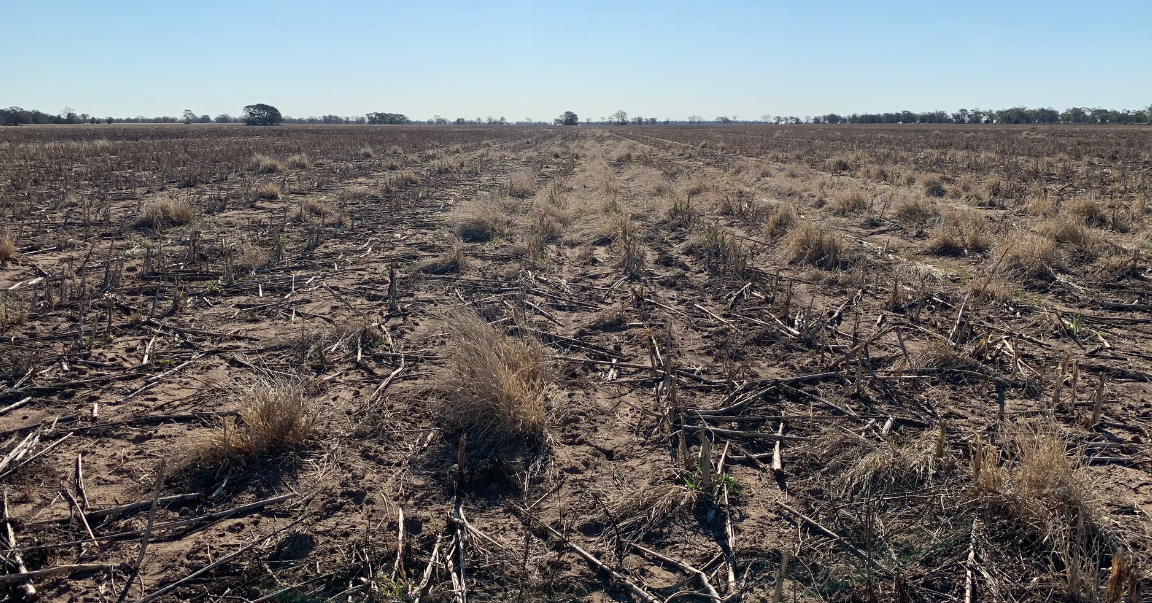
Moree Demonstration site
Details and history of the site
Location: 20 km east of Moree
Consultant
Sam Simons from Poole Ag Consulting

Site background
The site has had a history of a few FTR escapes over the past few years. There was seed set and dispersal through the drought, with little opportunity for residuals during this time and camera sprays generally underutilised.
Wheat was fallowed through to sorghum in 2019-20.
In the 2019-20 sorghum crop, Dual Gold plus atrazine was applied pre planting. 60mm overnight rainfall occurred after planting, with good follow up summer rain. Under this scenario the Dual Gold was not able to provide full season weed control. Several FTR germinations occurred during the sorghum crop. Inter-row cultivation was also utilised, but this still left too many behind. Sorghum was harvested late June, however mature FTR plants had set seed prior to harvest.
The intent is to fallow the paddock to wheat in 2021; with chickpeas planned for 2022; barley in 2023 and then fallowed to summer crop (sorghum or cotton) in 2024/25.
Plan
Multiple tactics required
- Deep Ripping for soil structure and nutritional benefits
- Summer residuals 20-21
- Knockdowns with Group A’s and double knocks
- Camera sprayer on farm
Treatments

Status updates
August 2020
As FTR management in this paddock was proving to be difficult, it was selected to host the demonstration.

Image above: Large existing FTR plants were still present in the paddock over winter following the previous sorghum crop, with a known FTR seedbank in the soil.

Image above: The first spring flush of FTR emerged in August
September 2020
The grower elected to apply a broadcast application of glyphosate + clethodim followed by paraquat + imazapic across the whole paddock for general summer long residual weed control. This was followed by 35mm of rain the following week. It appears that the timing of this double knock was not able to control the FTR that established the month prior.
While providing broadspectrum residual control of several weeds in fallow, imazapic is poor at controlling already emerged weeds such as FTR.
October 2020

Image above: In late October, a section of the site was deep - Site ripped to 350-400mm on 500mm centers using a Gessner Rhino plough. The mechanical cultivation was included partially to remove old FTR plants and the new flush however also for soil structure and nutritional benefits.
November 2020
Early November the remaining FTR plants (which were mostly in the un-ripped section) were sprayed with a glyphosate + Group A tank mix applied as a blanket application across the whole site.

Image above: Patches of herbicide affected FTR following the blanket knockdown application.
When targeting FTR in fallow with Group A herbicides it is always recommended to double knock with paraquat in about 7 days. This is important to both achieve robust control and also to delay selection for resistance.
In this case, a double knock was not applied. The intention was to apply residual herbicide strips in the non-ripped section of the site, so the decision was made to delay the next application until there was a forecast of rainfall to incorporate the residuals. In hindsight, the next rainfall event was several weeks later and the decision not to apply the double knock resulted in only partial FTR control from the knockdown application and significant escapes.
December 2020
In the first week of December there was a forecast for storm rainfall so different residual herbicide strips (below) were applied on December 2, with 15mm rainfall occurring that night.
- Balance 100g/ha
- Balance 100g/ha + Dual Gold 1.5L/ha
- Balance 100g/ha + Fist 456g/L (pendimethalin) 2L/ha
- Balance 100g/ha + Terbyne Xtreme 1kg/ha
These alternate treatments all included a base of Balance, which is an effective residual option for FTR where subsequent crop rotations permit its use. The addition of the other residual herbicides was included to evaluate performance on other weeds and/or improvement in control of FTR.
No additional knockdown herbicide was included with these residual herbicide treatments, so existing FTR remained from the previous knockdown application that was not double knocked.
Mature FTR seed from existing plants in and around this site was collected and will be sent for resistance testing.
January 2021
As a result of the ineffective knockdown applications prior to the application of the residuals there was still a concerning level of surviving plants post the residual herbicide applications, as per the photos below.

Image above: Control (Double knock including imazapic in September. Glyphosate + Group A in November)

Image above: Plus Balance strip in December

Image above: Plus Balance + Dual Gold strip in December

Image above: Plus Balance + Fist strip in December

Image above: Plus Balance + Terbyne Xtreme strip in December

Image above:The deep ripped area (that also had an application of Flame prior to the cultivation) is largely still clean of FTR
February 2021
There have been many rain events through summer, but appear to have been 2 visual FTR emergence events in the field since the flame and residuals went out.
Can see Balance is still active in the strips it went out on some volunteer sorghum and turnip weed. There are now big established plants that will be extremely difficult to kill without mechanical cultivation.
Deep ripped zone still best by a long way. Significant rain has fell through Feb and start of March
April 2021
Since my last update the whole field was Kelly chained to remove established weeds. Sakura strips have been applied and the field has just been planted to Flanker wheat. Light rain on it today.
Unfortunately due to the impacts of localised flooding, strategic cultivation and renovating was required through the trial site strips to fix wash outs and enable it to be planted to winter crop.
As such we felt that this would potentially confound any results this coming summer and have decided to establish a new demonstration site on another farm just north of Moree.
